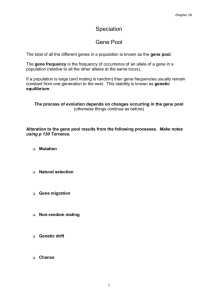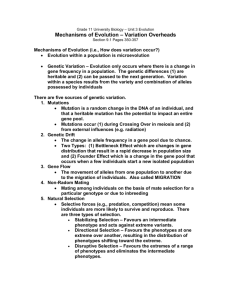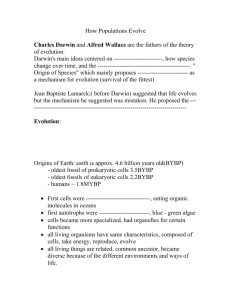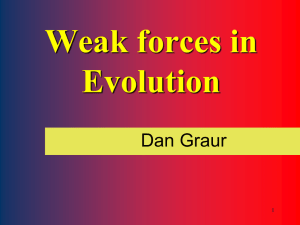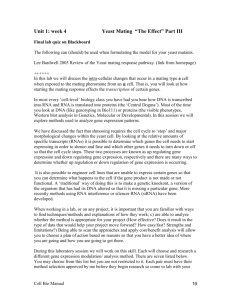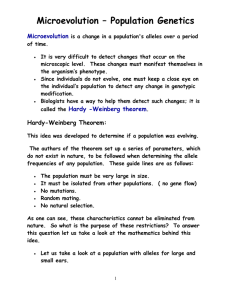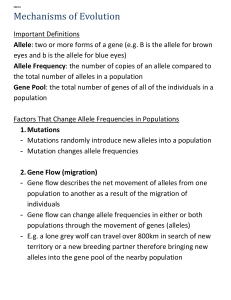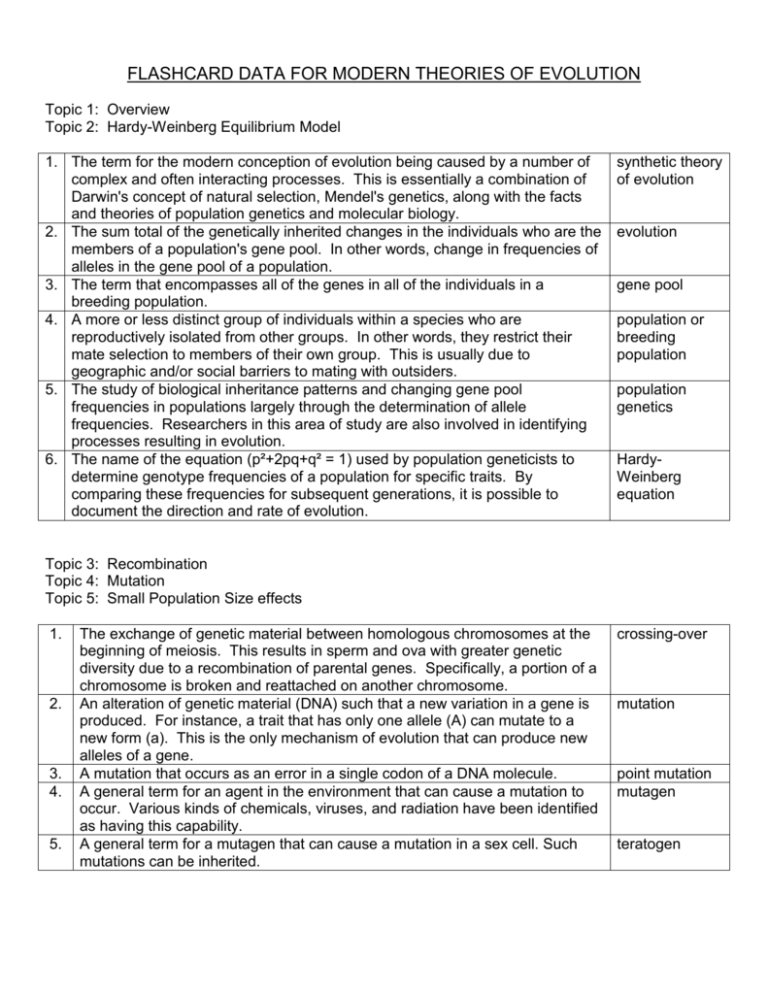
FLASHCARD DATA FOR MODERN THEORIES OF EVOLUTION
Topic 1: Overview
Topic 2: Hardy-Weinberg Equilibrium Model
1. The term for the modern conception of evolution being caused by a number of
complex and often interacting processes. This is essentially a combination of
Darwin's concept of natural selection, Mendel's genetics, along with the facts
and theories of population genetics and molecular biology.
2. The sum total of the genetically inherited changes in the individuals who are the
members of a population's gene pool. In other words, change in frequencies of
alleles in the gene pool of a population.
3. The term that encompasses all of the genes in all of the individuals in a
breeding population.
4. A more or less distinct group of individuals within a species who are
reproductively isolated from other groups. In other words, they restrict their
mate selection to members of their own group. This is usually due to
geographic and/or social barriers to mating with outsiders.
5. The study of biological inheritance patterns and changing gene pool
frequencies in populations largely through the determination of allele
frequencies. Researchers in this area of study are also involved in identifying
processes resulting in evolution.
6. The name of the equation (p²+2pq+q² = 1) used by population geneticists to
determine genotype frequencies of a population for specific traits. By
comparing these frequencies for subsequent generations, it is possible to
document the direction and rate of evolution.
synthetic theory
of evolution
evolution
gene pool
population or
breeding
population
population
genetics
HardyWeinberg
equation
Topic 3: Recombination
Topic 4: Mutation
Topic 5: Small Population Size effects
1.
2.
3.
4.
5.
The exchange of genetic material between homologous chromosomes at the
beginning of meiosis. This results in sperm and ova with greater genetic
diversity due to a recombination of parental genes. Specifically, a portion of a
chromosome is broken and reattached on another chromosome.
An alteration of genetic material (DNA) such that a new variation in a gene is
produced. For instance, a trait that has only one allele (A) can mutate to a
new form (a). This is the only mechanism of evolution that can produce new
alleles of a gene.
A mutation that occurs as an error in a single codon of a DNA molecule.
A general term for an agent in the environment that can cause a mutation to
occur. Various kinds of chemicals, viruses, and radiation have been identified
as having this capability.
A general term for a mutagen that can cause a mutation in a sex cell. Such
mutations can be inherited.
crossing-over
mutation
point mutation
mutagen
teratogen
6.
Evolution, or change, in gene pool frequencies resulting from random chance.
This process of evolution occurs most rapidly in small populations. In large
populations, random deviations in allele frequencies in one direction are more
likely to be cancelled out by random changes in the opposite direction.
7. A small population effect in which the genes of a few people (the originators of
the population) are inherited over time by a large number of descendents.
8. A severe genetically inherited fatal degenerative nerve disorder. The
symptoms usually do not appear until early middle age. There is a
progressive loss of muscle control that inevitably leads to paralysis and death.
This disease has been found at an extraordinarily high frequency among the
people in the Lake Maracaibo region of northwest Venezuela.
9. Members of a conservative Protestant sect related to the Mennonites. They
migrated to Pennsylvania from Switzerland in the late 18th century. The “Old
Order” communities of this sect are relatively closed groups that shun most
modern conveniences in their farming lifestyle. They use horse drawn
carriages, dress very simply, and reject those who marry outsiders. They are
similar to the Dunkers.
10. The general term for a dramatic reduction in genetic diversity of a population
or species resulting from an ecological crisis that wipes out most members.
The limited genetic diversity of the few survivors is the pool from which all
future generations are based. This is a small population effect.
genetic drift
founder effect
or principle
Huntington’s
disease
Amish
bottleneck
effect
Topic 6: Non-Random Mating
Topic 7: Natural Selection
Topic 8: Gene Flow
1.
2.
3.
4.
5.
Mate selection in which all individuals have an equal chance of being
selected. In other words, there is no conscious discrimination for or
against any individual or trait.
Mate selection based on one or more traits that are discriminated for or
against. This is a mechanism of evolution.
The form of non-random mating in which individuals who are not
genetically alike for particular traits mate and those who are alike do not.
The result is a progressive increase in the frequency of heterozygotes and
a decrease in the homozygotes for the discriminated traits.
The form of non-random mating in which individuals who are alike for
particular traits mate and those who are not alike do not. The result is a
progressive increase in the frequency of homozygotes and a decrease in
the heterozygotes for the discriminated traits.
The mating of closely related individuals, such as brothers, sisters, or
cousins. Another name for this mating pattern is "inbreeding." This is an
extreme form of positive assortative mating.
random mating
non-random
mating
negative
assortative mating
positive assortative
mating
consanguineous
mating
6.
7.
8.
9.
10.
11.
12.
13.
A genetically inherited recessive condition in which red blood cells are
distorted resulting in severe anemia and related symptoms that are often
fatal in childhood. People who are homozygous for this disease are
immune to malaria but die of the disease. Those who are heterozygous for
it have a high degree of immunity to malaria and have only minimal
symptoms of the disease. As a result, they are selected for in an endemic
malarial environment such as exists in much of sub-Saharan Africa.
The mutual, interactive effect on human evolution of biology and culture.
This term was developed to describe the effect our culture has on natural
selection.
A traditional low-technology land-clearing practice whereby trees and other
dense vegetation are cut and later burned. Ash from the burned
vegetation provides fertilizer for agricultural crops that are planted among
the remaining tree stumps. Since no other fertilizer is usually applied,
fields are abandoned after a few years, when crop yields go down, and
clearing occurs elsewhere.
An inherited metabolic abnormality that is fatal in early childhood. Eastern
European Jews have an unusually high frequency of this harmful recessive
allele in their population. However, it can occur in any human group.
The maintenance of two or more alleles for a trait in a population at a more
or less constant frequency ratio due to the selective advantage of
heterozygotes.
A life threatening disease found mostly in tropical and subtropical regions
of the world. It is caused by single-celled microorganisms that are
transmitted from person to person by mosquitoes as they extract blood.
Symptoms include chills, high fever, and sometimes fatal irregularities of
the brain, liver, kidney, and/or blood.
A usually fatal, slow acting disease caused by the Human
Immunodeficiency Virus (HIV). Important disease-fighting white blood cells
are destroyed resulting in a weakened immune system. Death usually
comes as a result of cancer and other diseases that are normally fought off
by healthy immune systems. HIV is spread from person to person via
bodily fluids such as blood and semen.
The transference of genes from one population to another, usually as a
result of migration, but not necessarily. The loss or addition of individuals
or their genes can easily change the gene pool frequencies of both the
recipient and donor populations--that is, they can evolve.
sickle-cell trait or
sickle-cell anemia
biocultural
evolution
slash-and-burn
Tay-Sachs disease
balanced
polymorphism
malaria
AIDS (Acquired
Immune Deficiency
Syndrome)
gene flow
Topic 9: Micro and Macro Evolution
1. The theoretical model of evolution in which species change slowly at a more or
less constant rate through time into other species.
2. Major evolutionary changes in a population's gene pool, occurring over many
generations, resulting in the evolution of new species.
3. Small changes in a population's gene pool occurring over a few generations.
The accumulation of these changes in allele frequencies over many generations
can result in macroevolution.
gradualism
macro
evolution
micro
evolution
4. The theoretical model of evolution in which species remain unchanged for long
periods of time and then at times rapidly change as a result of major alterations
in the environment and, subsequently, in natural selection.
5. The progressive diversification of a species into two or more species as groups
adapt to different environments. Natural selection is usually the principle
mechanism driving this evolution.
6. Evolution within a single evolutionary line without the branching of adaptive
radiation. This takes place when the members of a species consist of a single
breeding population for many generations. Descendent generations experience
continuous spontaneous mutations and new directions of natural selection as
the environment changes. As generations subsequently replace each other, the
gene pool is transformed--i.e., it evolves.
Copyright © 2005-2012 by Dennis O'Neil. All rights reserved.
punctuated
evolution
cladogenesis
anagenesis


